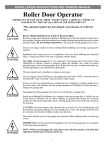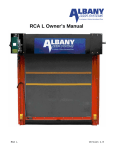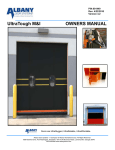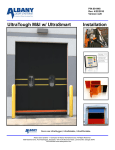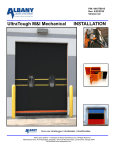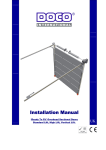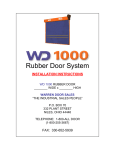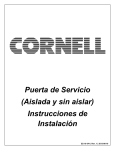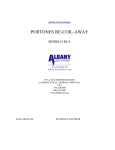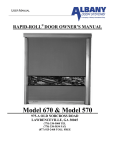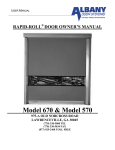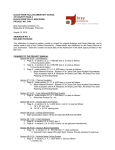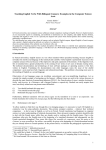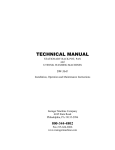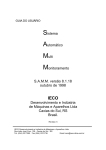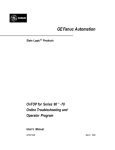Download M&I Re-Coil-Away 70 - Albany Door Systems
Transcript
190-002-.doc July 2001 RE-COIL-AWAY 70 DOOR OWNERS MANUAL WITH DOOR-MOUNTED OUTBOARD COUNTERBALANCE SPRINGS OR SPRINGLESS DESIGN WITH INERTIA BRAKE Serial No.: Contents: * Description of Components * Warranty * Framing Detail * Installation Instructions * Maintenance * Troubleshooting * Parts List 975-A OLD NORCROSS ROAD LAWRENCEVILLE, GA 30045 (770) 338-5000 TEL (770) 338-5034 FAX (877) 925-2468 TOLL FREE 190-002-.doc July 2001 RE-COIL-AWAY 70 DOOR OWNERS MANUAL WITH DOOR-MOUNTED OUTBOARD COUNTERBALANCE SPRINGS OR SPRINGLESS DESIGN WITH INERTIA BRAKE Serial No.: Contents: * Description of Components * Framing Details * Installation Instructions 975-A OLD NORCROSS ROAD LAWRENCEVILLE, GA 30045 (770) 338-5000 TEL (770) 338-5034 FAX (877) 925-2468 TOLL FREE DESCRIPTION OF COMPONENTS MODEL 70 CURTAIN The entire curtain is composed of 1/4" thick Styrene Butadiene Rubber (SBR) with an additional thickness of rubber attached vertically on each side of the curtain. The inner side of this additional rubber segment is bevelled to form the patented windlok action within the guides. Polyethylene fabric strips (PET weave) are bonded to the bevelled edges of the windloks to minimize friction within the guides should significant wind or air pressure build up on the curtain during operation. The top edge of the curtain is secured to the drive barrel thus providing the coiling action which raises and lowers the curtain. DRIVE BARREL (for models with outboard springs) The drive barrel consists of a steel tube and a drive shaft at each end. Steel inserts enclose the ends of the drive barrel and provide support for both drive shafts. (for models with springless design) The drive barrel consists of a steel tube containing a free shaft at one end and a drive shaft at the opposite end. Steel inserts enclose the ends of the drive barrel and provide support for both the free and drive shafts. DRIVE END BRACKET The drive end bracket supports the drive shaft which is inserted into a bearing in the centre of the drive end bracket. A mounting angle is then bolted to the back of the drive end bracket, thus securing it to the face of the opening. SPRING OR FREE END BRACKET The spring/free end bracket supports the drive shaft which is inserted into a bearing in the centre of the spring/free end bracket. A mounting angle is then bolted to the back of the end bracket, thus securing it to the face of the opening. OUTBOARD COUNTERBALANCING SPRING Assembly could consist of one to six spring assemblies. The outboard counterbalance spring assembly is supported by a flange bearing at each end. A pair of sprockets and roller chain connects the outboard counterbalance spring to the drive barrel. Tension is applied from the torsion springs during the closing cycle, thus providing a counterbalanced curtain. A cover is optional for protection and/or appearance. SPRINGLESS WITH INERTIA BRAKE Door sizes which are less than or equal to 150 square feet in size do not require a stop lock bearing unless specifically required for safety purposes. All door size over 150 square feet are standard with stop lock bearing. The inertia brake is attached to the free-end bracket and is keyed to the free-end shaft. This safety device is designed to lock the free-end shaft and the drive barrel should the door free-fall. Section I – Component Description 1 DESCRIPTION OF COMPONENTS MODEL 70 INERTIA BRAKE (cont’d) The ratchet wheel and control disc are fixed and driven by the shaft. The scanning roll which is mounted on the pawl is moved up and down by the control disc. The pawl passed between the teeth of the ratchet wheel without touching them. If the trip speed is exceeded, the scanning roll lifts and the pawl grips into the teeth of the ratchet wheel. The shaft is slowed down by the damping bar which is made of non-corrosive and thermally stable high grade steel. It is impossible to operate the safety device when the damping bar is distorted (bent). This is ensured by a spring which locks the catch and the ratchet wheel. The damping bar has to be replaced or bent to its original shape before the safety device can be reused. It is not possible to operate the door electrically when the safety device is activated. A disconnect switch interrupts the control circuit of the operator when the damping bar is bent. The door can be opened if operator is equipped with a manual opening feature (e.g. chain hoist, crank handle). The Self-Aligning Bearing A safety device can be used as the bearing for one side of the shaft. It has the characteristics of a self-aligning ball bearing. Therefore, the safety device too is a bearing swinging around the axis of symmetry of the stub shaft. When the bearing is beyond the middle, there will be shear and lateral movement. The effect is additional load on the shaft and the safety device. The Patented Damping Bar The highest shock load on the door and its mounting is when the shaft locks during free-fall. The resultant forces are too high for the rolling shutter. With a safety device from ELEKTROMATEN with patented damping bar you can forget all these problems. When catching the falling door, the damping bar is distorted “softly”(there will be no load which can damage the door). The kinetic energy of the falling door is transformed into bending energy. The additional load during the crash is limited to 1.6 x standard load. Without damping, it would be 10 x higher. Therefore, safety devices without a damping bar do not eliminate shock load! Section I – Component Description 2 DESCRIPTION OF COMPONENTS MODEL 70 INERTIA BRAKE (cont’d) The Ratchet (Catch) In the event of failure of one of the holding parts (gearing, brake system, drive chain), the rolling shutter will go into a “free-fall”. The speed of rotation increases until the releasing speed is reached. Now the scanning roll takes off from the control disc and the pawl grips into the engaged position. The falling door is stopped when the pawl grips into the ratchet wheel and the shaft is locked. The resultant forces are no longer transferred from the “sensitive” ball bearing of the ratchet (catch) to the damping bar. They are guided by a large steel bolt which supports the ratchet. The ball bearing will not be damaged by the impact. The safety device will remain intact after arresting the door. It can be used again after replacement of the damping bar. The Electrical Disconnect After the safety device has been activated, it is impossible to operate the door electronically until the distorted damping bar is replaced. Before changing the damping bar, locate the cause of the problem and repair the defect. There may be different reasons for the release of the safety device. It is not always caused by a broken gear or drive chain. Its operation can be initiated by a loose chain, defective or fading brakes, displaced lath or damaged tracks. Section I – Component Description 3 DESCRIPTION OF COMPONENTS MODEL 70 IDLER BARREL The idler barrel is located just below the drive barrel and is attached to the end brackets by the shafts at either end of the idler barrel which are inserted into the bearings provided at the base (and near the back) of each end bracket. The rubber curtain is maintained between the idler barrel and the wall above the lintel, thus ensuring minimal air loss. GUIDES The guides are composed of pre-assembled lengths of structural steel which, when positioned vertically on either side of the opening, provide an enclosed channel for each side of the curtain, thus completing the “windlok” feature. The front and back sections of the guides are hinged together to allow the curtain to be easily re-inserted into the guides after severe impacts. FACTORY SUPPLIED MOUNTING STEEL (Optional Feature) Some door systems are supplied from the factory with the guides and plate angles welded to mounting steel. This mounting steel may consist of the flat bar or rectangle tube as prescribed on the framing detail or it may be a special design to incorporate a travelling windbar recessed into the jambs. In all of these instances, follow the instructions in the Installation Section for Guides. WINDING HUB (for models with outboard spring assembly only) The winding hub is used to apply tension to the torsion springs on the outboard counterbalance spring assembly. The winding hub on the end of the spring assembly contains a series of holes for the insertion of a tension rod and set screws to retain the desired tension. BOTTOM BAR The bottom bar of the curtain is reinforced with structural steel angle and flat bar which are bolted together to resist the natural bending action of the curtain and to maintain it parallel with the floor. The bottom bar is also equipped with a centre ‘break-away’ feature which provides easy straightening in case it is bent under impact. Door widths, greater than 20-feet, are not equipped with this feature. The underside of the bottom bar is equipped with a flexible reversing edge. The reversing edge provides an emergency stop and/or instant reverse of the door during the closing cycle should an obstruction be present in the opening. The reversing edge also provides a flexible seal between the bottom of the door and the threshold. ELECTRIC OPERATOR Model FDGH electric operator with rotary screw-type limit switches, electromechanical disc brake, helical gear reducer and emergency hand chain for manual operation. Motor and sprockets are to be of capacity to handle either single speed or two-speed operation. Section I – Component Description 4 ALBANY DOOR SYSTEMS Limited Warranty All door systems manufactured by Albany Door Systems Limited are warranted from the date of purchase against defects in materials and workmanship as follows: (i) door systems in general...one (1) year; (ii) rubber curtains (where applicable)...Lifetime Warranty. If within this period of time any part is found to be defective, new or remanufactured parts will be furnished free of charge, F.O.B. our plant in Lawrenceville, GA., provided that recommended installation and maintenance procedures (as outlined in our Service Manual and Installation Instructions booklet) are followed. In cases where the manufacturer's warranty of certain parts connected with our door systems (i.e.: electrical motors, switches, etc.) is less than the Albany warranty, the manufacturer's warranty will apply. The Albany warranty does not include replacement of parts due to normal wear and tear, damage beyond the control of Albany (i.e: damage in transit, impacts, etc.), or any labour charges incurred in the removal and/or replacement of defective parts. Warranty claims must be made to Albany (or to the authorized distributor from whom the purchase was made), and defective parts to be returned for verification or replacement must be forwarded prepaid to: ALBANY DOOR SYSTEMS 975-A Old Norcross Rd Lawrenceville, GA 30045 Alban Door Systems STATEMENT OF WARRANTY RE-COIL-AWAY SBR Curtain LIFETIME WARRANTY ON SBR Curtain material. Albany Door Systems warrants to the original owner of the door that the door panel fabric and components (windlock) will be free of defects in material and workmanship for as long as the door is installed in its original opening or building. Only defects brought to the attention of Albany Door Systems during the warranty period will be covered by this warranty. Albany Door Systems will replace any component parts which are found to be defective upon inspection by an Albany Door Systems representative. This warranty does not cover damage caused by collision or other abuse of the product. Adjustments made to the Control Panel or to the mechanical operation of the door without the authorization of Albany Door Systems will void this warranty. The replacement provisions shall be the limit of Albany Door System’s responsibility under this warranty and Albany Door Systems shall not be responsible for any other losses or damages due to the operation of any door or parts covered by this warranty. No other oral or written representations made by Albany Door Systems or its agents are a part of this warranty unless specifically set forth in writing by an authorized Albany Door Systems official. THE ABOVE SET FORTH WARRANTY IS SELLER'S SOLE WARRANTY. SELLER MAKES NO OTHER WARRANTY OF ANY KIND WHATSOEVER, EXPRESSED OR IMPLIED; AND ALL IMPLIED WARRANTIES OF MERCHANTABILITY AND FITNESS FOR A PARTICULAR PURPOSE WHICH EXCEED THE AFORESTATED OBLIGATION ARE HEREBY DISCLAIMED BY SELLER AND EXCLUDED FROM THIS AGREEMENT. M&ISBR9/99 INSTALLATION INSTRUCTIONS MODEL 70 Refer to the Framing Detail Drawing and Shop Drawing as required. FACTORY SUPPLIED MOUNTING STEEL (Optional Feature) If your door system has been supplied from the factory with the guides and plate angles welded to mounting steel, please note the following: 1. Follow the standard procedure for mounting the door guides to the wall, however, weld or fasten the mounting steel rather than the guide. 2. The left and right plate angles have been pre-.mounted; therefore, this step can be disregarded in the installation. 3. For shipping purposes, the door assembly is fastened to the skid using an additional set of inside plate angles. When installing the door assembly, remove the back spreader bar that attaches to these inside plate angles and re-install once the door is in place. Discard the inside plate angles that were used for shipping. If the door system utilizes double plate angles (an inside and an outside set), the outside set will be fastened on the skid and must be mounted with the door assembly and welded to the mounting steel. 4. If the framing steel supplied incorporates the travelling windbar track, disregard the instructions for mounting the windbar tracks GUIDES The guides supplied with this door system are as per Figure #1-1. The top of each guide front plate have the corners rolled back. They do not require dismantling prior to installation. Section II – Installation Instructions 1 INSTALLATION INSTRUCTIONS MODEL 70 GUIDES (cont’d) As proper placement of the guides is critical to the overall installation of the "Re-CoilAway”, please follow instructions carefully. 1. Prior to installation, check that the width of the opening matches the width of the door as ordered for that opening. 2. Check that the guide mounting steel is plumb (+/- 1/4"). 3. Using a water hose level or transit, check that the underside of the lintel is level (1/4" tolerance). Measurements from the underside of the lintel to the floor on both sides of the opening should not vary by more than 1" from the length of the door as ordered for that opening. 4. Again, using a water hose level or transit, scribe a horizontal line 6" above the underside of the lintel on the mounting steel on the left side of the opening (see Figure #1-2). Continue this horizontal line across the front of the opening and scribe another line on the mounting steel on the right side of the opening (see Figure #1-2). If actual measurements or calculations as referred to in Steps 1, 2 or 3 exceed the tolerance indicated, contact our office before proceeding further with the installation. 5. Place the "left guide" flush with the inside edge of the mounting steel on the left side of the opening (see Figure #1-2). Position the top of the guide to correspond with the scribed line 6" above the underside of the lintel (see Figure #1-2). Ensuring that the guide is exactly perpendicular, attach it to the mounting steel by fillet welding (using approximately 12" centres) down the entire length of each side of the guide where it contacts the mounting steel (see Figure #1-2). 6. Repeat Step 5 with the "right guide". 7. The clearance of /2" (+ /16") in the guide opening (see Figure #1-1), which allows the curtain to move freely within the guides, has been determined at the factory. However, to ensure that this clearance has not been affected due to rough handling 1 during shipping or erection, simply pass a /2" bolt through the guide opening to check for possible wide or narrow areas. If any variations are encountered, simply spread narrow areas open with a pry bar or reduce over-width areas by striking the outside portion of the guide with a hammer. 8. Unbolt the hinged portion of both guides so that the curtain can be inserted later. Erection of the guides is now complete. 1 1 Section II – Installation Instructions 2 INSTALLATION INSTRUCTIONS MODEL 70 GUIDES (cont’d) Section II – Installation Instructions 3 INSTALLATION INSTRUCTIONS MODEL 70 CURTAIN Inspect the curtain while it is mounted on the pallet (see Figure #2-1) and you will notice that one end bracket is equipped with an operator mounting plate while the other one is not. The end bracket with the mounting plate is referred to as the drive end bracket and the other is referred to as the spring end bracket. Erection of the curtain (following erection of the guides) should proceed as follows: 1. Remove the idler barrel from the door by removing the bolts in each end bearing. Slide the barrel free from the endplates and place aside for later assembly. 2. Unbolt the two (2) angle pieces attached to each end bracket (thus unbolting them from the pallet) so they can be mounted on each side of the opening. Section II – Installation Instructions 4 INSTALLATION INSTRUCTIONS MODEL 70 CURTAIN (cont'd) 3. Ensuring they will be mounted on the face of the opening in the same up and down position as they were mounted on the end brackets (see Figure #2-2), mount the angle pieces on the mounting steel as follows: Place the left angle piece so that its outside edge is flush with the outside edge of the left guide, ensuring at the same time that the bottom edge of the angle piece rests on the top edge of the left guide that is welded to the mounting steel (see Figure #2-2). Weld the inside edge of the angle to the mounting steel, then weld the top edge of the angle piece, and then plug weld the holes provided in the angle piece (see Figure #22). Do not weld along the outside edge of the angle piece. Repeat the above procedures with the right angle piece. The opening is now ready for installation of the curtain. Section II – Installation Instructions 5 INSTALLATION INSTRUCTIONS MODEL 70 CURTAIN (cont'd) 4. The curtain/end bracket assembly may then be lifted into place and the end brackets re-bolted to the angle pieces mounted on the face of the opening. Caution: Do not remove the ropes securing the curtain in a rolled-up position. Care should be taken when lifting the curtain so as not to damage the bottom bar and reversing edge (if applicable) attached to the bottom of the curtain. 5. With the curtain now in place, loosen the set screws in the flange bearing at the centre of the spring and drive end brackets. Center the curtain between the end brackets. Clearance should be approximately 2". Using a medium grade thread locker, tighten all set screws. 6. Check that the top of the two end brackets are level with each other. If levelling is required, either end bracket may be re-positioned by loosening the bolts that attach them to the angles and adjusting the bracket up or down within the slotted area provided. 7. Some door systems will require bracing from the wall to the end brackets as shown in Figure #2-3. Depending upon the size of the door, structural angle is supplied from the factory with door system. Section II - Installation Instructions 6 INSTALLATION INSTRUCTIONS MODEL 70 RE-COIL-AWAY SPREADER BAR ADJUSTMENT The following procedure can be applied for wide doors where the spreader bars may deflect upward to a point that is either physically or aesthetically unacceptable for hood installation. 1. Cut a wooden spacer (2” x 4”) to fit tightly between the two (2) front spreader bars at mid-span. 2. Position a lifting mechanism (lift-truck forks or hoist strap) below the bottom spreader bar at the spacer location and apply a minimal upward force. 3. Loosen all fasteners on the front cross braces. 4. Apply an additional upward force to deflect the spreader bars approximately 2” above level. 5. Tighten all fasteners on the front cross braces. 6. Remove the lifting mechanism and evaluate the resulting deflection for acceptability. Section II – Installation Instructions 7 INSTALLATION INSTRUCTIONS MODEL 70 ELECTRIC OPERATOR MODEL FDGH 1. Install the door sprocket tight against the flange bearing with a ¼” key (supplied). 2. Loosely mount the operator on the drive end plate with the ½ NC x 1-3/4” bolts with flat washers, lock washers and nuts. 3. Connect the drive chain and adjust the alignment by re-positioning the door sprocket. 4. Set the chain tension using the slots provided in the drive end bracket. The chain should not have more than ¼” slack. 5. Tighten all operator mounting bolts. 6. Remove the ropes securing the curtain around the drive barrel and manually lower the curtain to the closed position. Watch that the limit switches do not get damaged by “over travel”. CAUTION: The ropes keeping the curtain wrapped on the drive barrel can be removed only if the drive chain is installed and both guide front plates have been removed from the guide assemblies. Section II – Installation Instructions 8 INSTALLATION INSTRUCTIONS MODEL 70 ELECTRIC OPERATOR MODEL FDGH IMPORTANT: TRANSPORT PROTECTOR This operator is supplied with a breather valve installed. Remove transport protector before commissioning to allow the valve to function properly. Simply pull the transport protector (rubber strap) to remove. Section II – Installation Instruction 9 INSTALLATION INSTRUCTIONS MODEL 70 FOR MODELS WITH OUTBOARD COUNTERBALANCE SPRINGS SPRING PRE-CHARGE 1. 2. 3. Using winding bar #1, insert into winding hub and rotate up (direction shown below) not letting go until winding bar #2 has been inserted in following slot. Using winding bar #2, remove winding bar #1 and repeat Step 1, placing winding bar #1 into following slot. Repeat until required number of revolutions specified on the ID tag have been applied to spring (diagram shows ¼ revolution). Section II – Installation Instructions 10 INSTALLATION INSTRUCTIONS MODEL 70 FOR MODELS WITH OUTBOARD COUNTERBALANCE SPRINGS STRETCHING SPRING Using both winding bars, stretch spring the required distance specified on ID tag (as shown below) IDLER BARREL 1. Prior to installing the idler barrel, remove the ropes securing the curtain in a rolled-up position, and by using the manual chain hoist, lower the curtain until it hangs 2" below the top of the opening. Making sure that the idler barrel is in front of the curtain; lift the idler barrel into position. Insert the bearing mounting bolts and tighten them into place. Position the idler barrel so that the main body of the barrel is an equal distance from each end bracket (approximately 3-1/2 on either side). Tighten the set screws (use a medium grade thread locker on all set screws) located in each end bearing. 2. Using the manual chain hoist, lower the curtain until it hangs approximately 12" below the opening, and then close the guides which will in turn secure the curtain and the steel ends of the bottom bar. Section II – Installation Instructions 11 INSTALLATION INSTRUCTIONS MODEL 70 IDLER BARREL (cont’d) 3. Directly behind the idler barrel, check the spacing between the curtain and the back wall. There should be no more than a maximum of 1/4" and no less than a minimum of 1/8" clearance between the curtain and the back wall. To reduce or increase this clearance, the idler barrel can be adjusted by loosening the bolts on the flange bearings which support the idler barrel on the end brackets. The slotted holes in the end brackets allow the idler barrel to be moved in the proper direction. The bolts on the flange bearings can then be tightened to secure the idler barrel in the correct position. Care should be taken to ensure that the curtain is not being pressed between the back wall and any point along the length of the idler barrel. 4. As proper tracking of the curtain is essential to trouble-free operation, a final check should be made at this point to determine if the curtain is positioned at a 90o angle to the upright guides. This can be accomplished by completely unbolting and opening the front portion of either the left or right guide and viewing the position of the outer edge of the curtain as it is lowered with the manual chain hoist. If the curtain tracks to either side as it is lowered, the raising or lowering of either the spring or drive end bracket will easily correct any problem of improper tracking. Refer to Page 1 of the Troubleshooting Section. After determining that the curtain is at the proper 90o angle, simply re-bolt the front guide plate into position and, after necessary electrical connections are made to the operator and control panel along with final adjustments of the "Open" and "Close" limit switches, your "Re-Coil-Away" Door will be ready for use. 5. Clear plastic film is wrapped around the curtain to prevent soiling of the curtain during the shipping and installation. This plastic wrap must be removed prior to operating the door. Removal can be facilitated by manually lowering the door into the closed position. Section II – Installation Instructions 12 INSTALLATION INSTRUCTIONS MODEL 70 FOR MODELS WITH OUTBOARD COUNTERBALANCE SPRINGS LINTEL SEALING STRIP Every “Re-Coil-Away” Door System is supplied complete with a “Lintel Sealing Strip”, the purpose of which is to seal the area between the header and the curtain. To install the lintel sealing strip, use fasteners appropriate to the material used as lintel (or use ¼” TEK self-tapping screws supplied with each door and located in the hardware carton. For further details refer to drawings shown below. Sealing strip holder – length minus door width minus 1” Sealing strip – length minus door width plus 1” Fasteners located on 12” centres LINTEL SEALING STRIP DRAWING 89 B 015 Section II – Installation Instructions 1 INSTALLATION INSTRUCTIONS MODEL 70 LIMIT SWITCH ADJUSTMENT IMPORTANT: MAKE SURE THE TRAVELLING CAMS DO NOT ENGAGE THE LIMIT SWITCH WHEN USING THE MANUAL CHAIN HOIST. 1. Remove the cover from the limit box located on the electric operator.. 2. Use the manual chain hoist to position the bottom of the door approximately 18” below the lintel. 3. Depress the cam guide plate and turn the left cam until it engages the “open” limit switch on the left. The switch will click when the contact is made. 4. Insert the cam guide plate into the nearest slot in the cam. 5. Use the manual chain hoist to position the bottom of the door approximately 18” above the floor. 6. Depress the cam guide plate and turn the right travelling cam until it engages the “close” limit switch on the right. The switch will click when the contact is made. 7. Insert the cam guide plate into the nearest slot in the cam. 8. The door can now be cycled by the electric operator. Fine tune the travelling cams between the cycles until acceptable limits are obtained. Note: Turning either cam away from its respective limit switch will increase door travel. Section II – Installation Instructions 14 INSTALLATION INSTRUCTIONS MODEL 70 CONNECTING TO POWER SUPPLY Consult local electrical codes before proceeding with permanent installation. WARNING! Exercise caution when engaging electric operator. The drive and limit chains are exposed and if turning could cause injury. Install control panel, etc as required. Make the necessary electrical connections to the operator and control panel. Wiring diagrams can be found inside the control panel. On 3-phase units, make certain the operator rotates in the correct direction. If the direction is wrong, the limit switches will not function and damage could occur. It is recommended that the door be moved manually to mid-position before turning on the power so that it may be stopped before damage occurs should rotation be incorrect. If the direction is wrong, reverse any two (2) of the three (3) incoming power supply leads to correct rotation. CONNECTION OF A REVERSING EDGE A separate 24 volt electrical circuit is provided for the connection of a reversing edge. Any such device that uses a normally open contact may be connected to the two (2) reversing edge leads on the terminal strip located in the control panel. When the door comes in contact with an object during downward travel, the circuit causes the motor to stop and/or reverse the direction of the door. INERTIA BRAKE WIRING INSTRUCTIONS INSTALLATION INSTRUCTIONS Section II – Installation Instructions 15 MODEL 70 INERTIA BRAKE WIRING INSTRUCTIONS (cont’d) 1. 2. 3. 4. 5. The inertia brake must be wired in series to the hoist interlock switch. Connect the No. 7 wire coming from the control panel to one wire from the inertia brake using a marret. Connect the other wire from the inertia brake to terminal No. 7. Connect wire No. 8 from the control panel to terminal No. 8 in the limit box. Refer to wiring diagram and schematic for further details. INSTALLATION INSTRUCTIONS Section II – Installation Instructions 16 MODEL 70 TRAVELLING WINDBAR ASSEMBLY This is an optional accessory item which may not be applicable to model ordered. Step 1 Drive Barrel Kit Installation Step 2 Instructions for Guide-Mounted Windbar Assembly Instructions for Jamb-Mounted Windbar Assembly Step 3 4” or 4-1/2” Windbar Tube Installation 6-5/8” or 8-5/8” Windbar Tube Installation Step 4 4” or 4-1/2” Windbar Tube Installation (cont’d) 6-5/8” or 8-5/8” Windbar Tube Installation (cont’d) Travelling Windbar Part Identification Section II – Installation Instructions 17 INSTALLATION INSTRUCTIONS MODEL 70 TRAVELLING WINDBAR ASSEMBLY – DRIVE BARREL DRIVE BARREL KIT INSTALLATION DRAWING NO. 94-0432 STEP 1 Note: If your door was supplied from the factory with a Travelling Windbar, proceed directly to Step 2. 1. With the door in the closed position, disconnect the power supply. 2. Determine dimension “A” and “B” from the chart and measure the drive barrel to the required locations. From these locations, move to the closest centre between curtain fasteners and mark the barrel 2” from the curtain edge. 3. Drill a ∅ 5/16” and tap 3/8 – 16 into the drive barrel at all locations. 4. Wrap a hold-down bar with the windbar strap (1-1/2 wraps) and pierce a hole through the strap layers that aligns with the hole in the hold-down bar. Fasten the strap to the drive barrel with a 3/8-16NC x 5/8” LG BHCS and flat washer. Repeat this procedure with the remaining windbar strap(s). 5. If you are installing a jamb-mount windbar, route the straps over the top of the curtain and down between the curtain and the bulk head. Check that the straps are not twisted. If you are installing a guide-mount windbar, feed the strap between the drive barrel and the curtain. This procedure may require further closing of the door with the manual chain hoist to loosen the curtain tension. IMPORTANT: Make sure the travelling cams do not damage the limit switch when using the manual chain hoist for this procedure. Section II – Installation Instructions 18 INSTALLATION INSTRUCTIONS MODEL 70 TRAVELLING WINDBAR ASSEMBLY – WINDBAR TRACK (Guide-Mount) STEP 2 – RE-COIL-AWAY WITH GUIDE-MOUNTED WINDBAR If your door was supplied from the factory with a guide-mount 6-5/8” or 8-5/8” Travelling Windbar, proceed directly to STEP 3 1. If you are installing a 4” or a 4-1/2” O.D. windbar, fasten one (1) windbar track bracket to each hole provided in the windbar tracks. Orient the windbar track bracket with the slot protruding beyond the track edge opposite the curve. Fasten each bracket to the track using one (1) 3/8-16NC x 5/8” LG BHCS per bracket. 2. With the door in the open position, disconnect the power supply. 3. There is a left-hand and right-hand windbar track. Determine the appropriate location for each track given that the curved side is furthest from the curtain and the stop bolt holes are at the bottom. 4. Determine the curtain to windbar track spacing required for your travelling windbar diameter (4”, 4-1/2”, 6-5/8” or 8-5/8” O.D.). 5. If you are installing a 4” or a 4-1/2” O.D. windbar, unbolt the respective guide fasteners which align with the mounting brackets. Discard these fasteners and attach the windbar track using the 3/8-16NC x 1-1/2” long HHCS and nuts provided. 6. If you are installing a 6-5/8” or an 8-5/8” O.D. windbar, position the windbar track to the guies accordingly and weld each guide bracket to the outside of the guide back plate with two (2) 2” long fillet welds. Section II – Installation Instructions 19 MODEL 70 INSTALLATION INSTRUCTIONS TRAVELLING WINDBAR ASSEMBLY – WINDBAR TRACK (Jamb-Mount) STEP 2 – ALL JAMB-MOUNTED WINDBARS 1. Fasten one (1) windbar track bracket to each hole provided in the two (2) windbar tracks. Orient the windbar track bracket with the slot protruding beyond the track edge opposie the curve. Fasten the bracket to the track using one (1) 3/8 – 16 NC x 5/8” long BHCS per bracket. 2. With the door in the open position, disconnect the power supply. 3. There is a left-hand and right-hand windbar track. Determine the appropriate location for each track given that the curved side is furthest from the curtain and the stop bolt holes are at the bottom. 4. Determine the curtain to windbar track spacing required for your travelling windbar diameter (4”, 4-1/2”, 6-5/8” or 8-5/8” O.D.). 5. Position the windbar track to the jamb accordingly and weld mounting bracket to the jamb or fasten thru the slot provided. Section II – Installation Instructions 20 INSTALLATION INSTRUCTIONS MODEL 70 TRAVELLING WINDBAR ASSEMBLY – WINDBAR TUBE INSTALLATION STEP 3 - FOR 4” OR 4-1/2” DIAMETER WINDBARS 1. Determine dimensions “C” and “D” from the chart and mark the lintel (jamb mount) or the spreader bar (guide mount) at these dimensions from the outside of the end plates. 2. If installing a jamb-mounted windbar, weld a lintel bracket at each mark on the lintel, 6” from the curtain. If installing a guide-mounted windbar, temporarily centre and clamp a “windbar strap clamp” at the specified location on the lower front spreader bar to match drill the 5/16” diameter holes. Section II – Installation Instructions 21 INSTALLATION INSTRUCTIONS MODEL 70 TRAVELLING WINDBAR ASSEMBLY – WINDBAR TUBE INSTALLATION STEP 3 (FOR 6-5/8” OR 8-5/8” DIAMETER WINDBARS) OPENING WIDTH (O.W.) O.W. <= 120’’ 120‘’ < O.W. <= 180’’ 180‘’ < O.W. <= 240’’ 240‘’ < O.W. <= 300’’ 300‘’ < O.W. <= 360’’ 360‘’ < O.W. <= 480’’ DISTANCE FROM OUTSIDE OF ENDPLATE TO STRAP LOCATION DIM ‘C’ DIM ‘D’ 9 ‘’ S/O 18’’ S/O 36’’ S/O 18’’ 42’’ 27’’ 48’’ 33’’ 60’’ 1. Determine dimensions “C” and “D” from the chart and mark the lintel (jamb-mount) or the truss (guidemount) at these dimensions from the outside of the end plates. 2. If installing a jamb-mounted windbar, weld a ratchet buckle at each mark on the lintel, 9” from the curtain (see Detail B). If installing a guide-mounted windbar, weld a ratchet buckle at each mark on the bottom of the truss (see Detail A). Section II – Installation Instructions 22 INSTALLATION INSTRUCTIONS MODEL 70 TRAVELLING WINDBAR ASSEMBLY – WINDBAR TUBE INSTALLATION STEP 4 (FOR 4” OR 4-1/2” WINDBARS) 1. With the door in the closed position, disconnect the power supply. *Note: Roller wheels may come factory-installed in windbar tube. 2. Insert a roller wheel into each end of the windbar tube. “Snuggly” install a set screw and nut (nut supplied as a spacer) in both ends of the windbar tube (do not over-tighten). With set screws in place, the roller wheels will extend and retract without separating from the windbar tube. 3. Lift the windbar into the bottom of the tracks. Insert a stop bold (3/8-16NC x 3-1/2” LG HHCS) into the hole at the bottom of each track and secure with a 3/8-16NC hex nut. 4. Route the windbar straps around the bottom of the windbar tube, then upward towards the lintel (jambmount) or spreader bar (guide-mount). Check that there are no twists in the straps. 5. Route the loose end of each windbar strap between individual windbar strap clamps and temporarily fasten to the lintel bracket (jamb-mount) or spreader bar (guide-mount). 6. Carefully raise the door to the open position. Examine the location of the windbar with respect to the to of its tracks. If adjustments to the windbar straps are required, return the door to the closed position to do so. 7. Once adjustments are complete, secure the windbar strap and clamps to the lintel bracket (jamb-mount) or spreader bar (guide-mount) with the fasteners provided. Trim excess strap material leaving at least 1-1/2” of extra strap hanging below the strap clamps and fasteners. Section II – Installation Instructions 23 INSTALLATION INSTRUCTIONS MODEL 70 TRAVELLING WINDBAR ASSEMBLY – WINDBAR TUBE INSTALLATION STEP 4 (FOR 6-5/8” OR 8-5/8” DIAMETER WINDBARS) 1. With the door in the closed position, disconnect the power supply. 2. Insert a roller wheel into each end of the windbar tube. 3. Lift the windbar into the bottom of the tracks. Insert one stop bolt (3/8-16NC x 3-1/2” LG HHCS) into the holes at the bottom of each track and secure with 3/8-16NC hex nuts. 4. Route the windbar straps around the bottom of the windbar tube, then upward towards the lintel for jambmount or spring truss for guide-mount. Check that there are no twists in the straps. 5. Route the loose end of each windbar strap through the slot in the spool of individual ratchets on the lintel for jamb-mount or on the spring truss for guide-mount. 6. Carefully raise the door to the open position, examine the location of the windbar with respect to the top of its tracks. If adjustments to the windbar straps are required, return the door to the closed position to do so. 7. Once the adjustments are complete, trim excess strap material, leaving a minimum of three (3) full wraps of strap on the spool of the ratchets. Section II – Installation Instructions 24 INSTALLATION INSTRUCTIONS MODEL 70 TRAVELLING WINDBAR ASSEMBLY – PART IDENTIFICATION Description: Travelling Windbar – 1 Required Application: Description: Door Width <= 20’ use 4” O.D. tube Door Width > 20’ use 4-1/2” O.D. tube Large RCA doors utilize 6-5/8” or 8-5/8” pipe Windbar Track Assembly – 2 Required Application: Design #1 For Standard Doors Design #2 For Large RCA Doors Description: Windbar Track Bracket – 4 Required (6 required for door heights over 14 feet) Application: Description: All Jamb-Mount and RCA Guide-Mount Windbar Strap – 2 Required (4 required for door widths over 20 feet) Application: Description: All Applications Hold Down Bar – 2 Required (4 required for door widths over 20 feet) Application: Description: All Applications Windbar Strap Clamp – 4 Required (8 required for door widths over 20 feet) Application: Description: Design #1 Roller Wheel - 2 Required Application: Description: All Applications Lintel Bracket – 2 Required (4 required for door widths over 20 feet) Application: Description: Design #1 Jamb-Mount Windbar ONLY Ratchet – 2 Required (4 required for door widths over 20 feet) Application: Description: Design #2 Jamb or Guide Mount Windbars 3/8 – 16NC x 5/8” LG BHCS(quantity varies) Application: Description: All Applications ¼ - 20NC x ¾” LG HHCS – 2 Required ¼ - 20NC Hex Nut Pl. – 2 required Application: Description: Design #1 ¼-20NC x 1-1/4” LG HHCS (quantity varies) Application: Description: Design #1, Jamb or Guide Mount Windbar ¼-20NC Whiz –Lock Nut (quantity varies) Application: Description: Design #1, Jamb or Guide Mount Windbar 3/8-16NC x 1-1/2”LG HHCS(quantity varies) Application: All Jamb and Guide Mount RCA Section II – Installation Instructions 25 INSTALLATION INSTRUCTIONS MODEL 70 TRAVELLING WINDBAR ASSEMBLY – PART IDENTIFICATION Description: 3/8-16NC x 3-1/2”LG HHCS – 2 Required Application: Description: All applications 3/8” Flat Washer (quantity varies) Application: Description: All applications 3/8-16NC Hex Nut (quantity varies) Application: All applications PART IDENTIFICATION DWG #94-0431 January 6, 1999 *Note: Hardware kits may contain fasteners that are not required for your application. Section II – Installation Instructions 26 MAINTENANCE MODEL 70 Due to the unique design features of "Re-Coil-Away", the need for continual maintenance normally associated with conventional door systems (i.e: guide rollers, hinges, door track, etc.) is virtually eliminated. The limited maintenance procedures listed below, when completed as indicated, will assure many years of trouble-free operation. DOOR ASSEMBLY There are two (2) flange bearings on the drive end bracket and two (2) flange bearings on the spring end bracket. These bearings are permanently lubricated for the life of the bearing and, therefore, require no further maintenance. ELECTRIC OPERATOR The operator is equipped with a main drive chain connected to one end of the output shaft and a limit drive chain connected to the opposite end of the output shaft. These chains should be oiled monthly to eliminate rusting and ensure proper chain life. Proper tension on the main drive chain (1/4" slack) should be maintained at all times to minimize chain and sprocket wear. A check of the tension should be made each time the chain is oiled. After wiring has been thoroughly checked and the electric operator is running properly, refer to "Limit Switch Adjustment" before using door. There are two (2) flange bearings mounted on the operator base which supports the gear reducer output shafts. These bearings are permanently lubricated for the life of the bearing and, therefore, require no further maintenance. The gear reducer (which forms part of the operator) is a sealed unit and requires no ongoing maintenance. However, a check of the oil level in the reducer once a year is suggested to determine that no leaks have developed in the oil seals. GUIDES The clearance of 1/2" (+/- 1/16") in the guide opening (which permits free up and downward movement of the curtain) has been determined at the factory. However, due to wind load, negative pressure and/or impacts, this clearance may vary in time. To ensure correct clearance, the guide opening should be verified every three (3) months by simply passing a 1/2" bolt through the guide opening along the entire height of the door. If any variation is encountered, simply spread narrow areas open with a pry bar or reduce wide areas by striking the outside of the guide with a hammer. The insides of the guides (the area inside which the windlok travels) should never be oiled or greased to ensure that free up and downward motion is maintained. Problems with movement of the curtain within the guides should be referred to our office. FASTENERS While performing any of the other maintenance tasks, check for any loose nuts, or bolts or screws and tighten if necessary. Also ensure that the suggested dimensional clearances and/or tolerances of the components connected by loose fasteners are adjusted as required. Section III - Maintenance 1 MODEL 70 MAINTENANCE FDGH BRAKE MOTOR 1. 2. 3. 4. 5. Brake End Shield Brake Disc Complete Stationary Disc Brake Spring Hand Lever for manually disengaging the brake; will re-engage itself when released 6. Manual Brake Release Screw for fixing Brake in the disengaged position. 8. Release Arm 9. Stud 10. Setting Nut 11. Conical Spring 12. 13. 14.. 15. 16. 17. 18. 20. 21. 22. Dowel Pin Fan Fan Guard Brake Coil Body Brake Adjustment Nut Retaining Screw Pressure Ring Counter Spring Carrier Spring Washer * Floating clearance 0.060”-0.080” **Working air gap 0.010”-0.024” MAINTENANCE Periodically clean the motors ventilation intake and its cooling fans for best cooling efficiency. The bearings should be checked, cleaned and re-greased every 5,000 hours of operation. The bearing should be greased to 1/3 of the available space between the outer race and the rolling members to avoid overheating. If brake disc #2 thickness becomes 9mm (0.350”), replace it (new brake disc thickness is 11.80mm or 0.465”). Otherwise, re-set air gap and floating clearance as required. Section III – Maintenance 2 MAINTENANCE MODEL 70 FDGH BRAKE MOTOR (cont’d) RE-SETTING THE BRAKE On a properly set brake, the air gap must be within 0.25 – 0.60 mm (0.010-0.024 inches). Prolonged use of the brake will wear the brake lining which will increase the air gap. As the air gap approaches its maximum value, re-set the brake as follows: 1. Remove fan cover #14. 2. Insert a feeler gauge between the brake coil body #15 and the pressure plate #3, tighten the adjusting nuts #16 until 0.25 mm (0.010”) air gap is reached equally all around. 3. Ensure a floating clearance of 1.5-2.0 mm (0.060-0.080 inches) in the releasing arm. TROUBLESHOOTING MALFUNCTIONS Fault – Motor does not run. 1) Check the wiring for damage and proper connection. 2) Measure the values of all three phases: resistance, voltage, current. 3) If, on all three phases, a current of similar value is present, either of the following conditions are evident: a) The motor may be blocked by either excessive external loads or defects in the reducer or the brake. In this case, the motor should draw locked rotor (in-rush) current. Contact our office for values. Release the brake mechanically, re-set the air gap if needed or disconnect load for shaft. b) If the brake is at fault electrically, see #4 below. c) If the current differs for electrical problems i.e. if it can be released mechanically but does not or it is connected for the wrong voltage. 4) Check the brake for electrical problems i.e. if it can be released mechanically but does not respond to voltage: a) Make sure the wiring is connected according to instructions. Pay special attention to the correct voltages. b) Energize the brake circuit and measure the AC voltage on rectifier terminals 2 and 3. The measured voltage should be identical to the nameplate inscription “brake voltage”. c) Measure the DC voltage on terminals 3 and 5 which should be about ½ of the previous measurement. d) If there is no fault found up to this point, measure the current into the rectifier and the resistance of the brake coils. Disconnect it from the rectifier for this purpose. Call our office, forwarding these values together with the drive’s serial number and other nameplate information. Special instructions for checking the BG/BGE rectifier can be obtained from our office. In case of rectifier failure, the brake coil has to be checked prior to start-up with the new rectifier. Fault: Brake does not hold load in time. If the brake has been operating well for some time and the change came about in a gradual manner, the release arm has probably run up against the coil body. Check arm end play. Section III - Maintenance 3 MODEL 70 MAINTENANCE Due to the unique design features of your new "RE-COIL-AWAY", the need for continual maintenance normally associated with conventional door systems (i.e.: guide rollers, hinges, door track, etc.) is virtually eliminated. The limited maintenance procedures listed below, when completed as indicated, will assure many years of trouble-free operation. AFTER INTIAL EVERY 25,000 CYCLES 1,500 CYCLES OR 3 MONTHS NO NO NO NO NO OIL OIL GREASE Grease, 1 shot OIL OIL GREASE NO CHECK LEVEL CHECK LEVEL (change oil every 200,000 cycles) Drive Chain Tension Limit Chain Tension Guides, bottom bar & header assembly for rust or damage Guide Opening 1/2" All Fasteners (check for tightness) Limit Settings Brake Air Gap Brake Pad Wear YES YES YES YES YES YES YES YES YES NO YES YES YES YES YES YES NO NO YES YES NO YES YES YES, every 350,000 cycles Reversing Edge (check for proper operation and any signs of damage) YES EVERY MONTH MAINTENANCE PROCEDURE LUBRICATE: Flange Bearing (4) Limit Chain Drive Chain Limit Shafts & Limit Cams Gear Reducer EVERY 100,000 CYCLES OR 12 MONTHS ADJUSTMENTS: (check & adjust if necessary) Section III - Maintenance 4 TROUBLESHOOTING MODEL 70 HOW TO WEDGE A CURTAIN Why would a curtain need a wedge? A wedge is used to correct uneven curtain build which can be evidenced by the following symptoms: (a) (b) (c) Bottom bar tracks to either right or left thereby causing it to jam against the guide, Bottom bar becomes out-of-level when door is in the open position, Curtain tends to 'cone' in one direction on the barrel, as the door is rolling up. What is a wedge? A wedge is a piece of waste rubber (can be as large as 6" square by as much as 1/2" thickness) which is strategically placed on the drive barrel between the curtain and the barrel. It is secured with a self-tapping screw(s). How to determine where to fasten wedge. It is normal for a curtain to 'float' slightly from side to side as the door rolls up and down. Wedging is required only when there is a severe tracking problem such as listed above. The placement of a wedge can be determined in several ways. For example, if the bottom bar is tracking to the left as the door is opening, then the wedge would be fastened on the right end of the barrel. The wedge would then make the curtain roll-up faster on the right side, thus making the bottom bar track evenly between the guides. Should the door be tracking to the right, then obviously the wedge should be fastened to the left end of the barrel. It is important to identify whether a door requires a wedge or if it has been installed out-oflevel. For instance, if a door rolls down with the bottom bar continually tracking to one side, eventually jamming near the floor, yet the curtain does not appear to 'cone', then the door is most likely out-of-level. To remedy the problem, it may be necessary to raise one of the end plates (which have slotted holes) to level the door. Section IV – Troubleshooting 1 TROUBLESHOOTING MODEL 70 REMOVAL AND RE-INSTALLATION OF CURTAIN IN GUIDES 1. Utilizing a 9/16" wrench, unbolt the hinged front guide plates of both the left and right guides. Swing the front guide plates open and place them to the side. 2. In the event that only the upper portion is hinged, raise the curtain and bottom bar until the bottom bar front angle is just below the open hinged portion. Then, lift the curtain one end at a time, out of the guides and set it outside the front guide plates. 3. Lower the curtain slowly and make sure that it does not catch on the guides. To reinstall the curtain, follow the above steps in reverse order. Be sure to close and bolt the front guide plates prior to putting the door back into operation. REMOVAL AND RE-INSTALLATION OF CURTAIN IN BOTTOM BAR 1. With the curtain and bottom bar supported on a flat surface, loosen both the 3/8" and 1/4" sets of bolts which secure the bottom bar to the curtain. 2. Slip the curtain out of the bottom bar. To re-install the curtain back into the bottom bar, follow the above steps in reverse order. If the bottom bar is equipped with an electric reversing edge, be sure to unplug the connector when removing the bottom bar. In addition, take extreme care not to damage the electric reversing edge fabric. A puncture would allow moisture to penetrate it, thus causing premature failure of the reversing edge. Section IV – Troubleshooting 2 TROUBLESHOOTING MODEL 70 REPAIRS TO RUBBER CURTAIN - RIPS OR PERFORATIONS In order to work on the ripped or perforated area, the curtain must be taken out of the guides and lowered to the floor. Then, either work on an area supported by the floor or alternatively, a solid, level surface provided by a heavy table, for example. Refer to Figure #5-1 and #5-2 for positioning of the curtain prior to repairing it. 1. Using a utility knife, set it to a depth that will penetrate the rubber down to the nylon cord centre of the curtain and cut a rectangular or square section approximately 2" wider than the sides of the rip or perforation. Be careful not to cut the nylon cord itself (see Figure #5-2). 2. Using a screwdriver and pliers and starting at one corner of the cut, peel the surface from the nylon cord centre within the perimeter of the cut. 3. Using coarse sandpaper or a wire brush, remove loose rubber particles from the nylon cord centre. However, it is not necessary to have the fabric 100% bare. 4. Flip the curtain over to the other side of the rip or perforation and repeat Step 1 through Step 3. 5. From the 1/8" thick piece of repair rubber, cut some pieces to inlay into the prepared areas. Using a grinder with a sanding disc or a wire brush, roughen-up the inlay surfaces for bonding. 6. Mix the adhesive as per the manufacturer's instructions and apply a liberal coating to the nylon cord fabric and the rough surfaces of the inlay rubber segments. Allow pieces to dry to the touch (about 15 to 20 minutes) and apply a second coating. Allow to set until tacky. Place the inlay segments into position and, using a rubber or rawhide mallet and a steel buckler, impact the entire area of the patch repeatedly. A high degree of impact ensures proper adhesion. Clamping is not acceptable. Allow the cement to cure thoroughly (1-1/2 to 2 hours) before moving the curtain. 7. Finally, raise the curtain to an open position, re-insert it into the guides, close and re-bolt the guides, and resume normal operation. Section IV – Troubleshooting 3 TROUBLESHOOTING MODEL 70 Section IV – Troubleshooting 4 TROUBLESHOOTING MODEL 70 NEOPRENE BOTTOM STRIPS - APPLICATION INSTRUCTIONS Should it become necessary to replace the UHMW corner plates originally installed on curtains supplied prior to 1987, they should be replaced with 2-1/2" wide x 1/8" thick neoprene belting as supplied by the manufacturer. To complete installation of the neoprene strips, the curtain must also be removed from the bottom bar. 1. Using an electric grinder, roughen-up the surface of the curtain onto which the neoprene strip is to be applied. Also roughen-up the contact surface on the neoprene strip itself. 2. Lay the neoprene strips (with rough side down) in place along the bottom edge of each corner. Match and mark the curtain attachment holes (see Figure #6-2) and cut or punch to suit. 3. As per the manufacturer's instruction, mix thoroughly in a separate container a supply of the Pangafol bonding cement and the Harter catalyst. As the mixed material has a pot life of only one (1) hour or less, mix only enough cement for the immediate area to be worked on. 4. Apply a coating of the bonding cement to the rough side of the strips and to the area on the curtain where the strips are to be attached. Note: Do not join the pieces at this time. Allow the cement to dry (until tacky) on both surfaces (about 15 to 20 minutes). 5. Apply a second coat of cement to both areas as per Step I. When the cement becomes tacky to the touch, place the rough side of the strips on the proper area of the curtain (see Figure #6-2) and press firmly in place. To ensure proper adhesion, place a piece of wood (or similar material) on the strips and tap firmly with a rubber mallet or hammer. A high degree of impact ensures proper adhesion. Clamping is not acceptable. Allow cement to cure thoroughly (1-1/2 to 2 hours) before re-inserting the curtain back into the bottom bar and/or the guides. Section IV – Troubleshooting 5 PARTS SECTION RE-COIL-AWAY MODEL 70 OUTBOARD COUNTERBALANCE SPRING ASSEMBLY Some quantities will change if door is equipped with more than one (1) spring assembly. ITEM NO. 1 2 3 4 5 6 QTY 1 1 1 1 2 2 DESCRIPTION SPRING ASSEMBLY SPRING SHAFT FLANGE BEARING SPRING PLATE BEARING BOLT BEARING NUT ITEM NO. 7 8 9 10 11 12 13 QTY 1 1 1 1 5 5 5 DESCRIPTION SPRING SPROCKET FREE END SPROCKET SPRING CHAIN SPREADER BAR SUPPORT BOLT LOCK WASHER NUT Section V – Parts List 1 PARTS SECTION RE-COIL-AWAY MODEL 70 END BRACKET ASSEMBLY ITEM # 1 2 3 6 7 8 9 10 10 QTY 1 1 4 1 1 -3 2 2 DESCRIPTION DRIVE END BRACKET ASSEMBLY LEFT INSIDE PLATE ANGLE FLANGE BEARING SPRING END BRACKET ASSEMBLY RIGHT INSIDE PLATE ANGLE CROSS BRACE SPREADER BARS 36” WINDING BAR (FOR USE WITH 1-1/2” OR 2” SHAFT) 19” WINDING BAR (FOR USE WITH 1-1/4” SHAFT) PART NUMBER 234-1XXX-XXXX 258-10X-1 405-12X-XXXX 234-3XX-XXXX 258-20X-1 308-00X-01 307-XXX-XX0*XXXX 390-059 390-057 Section V – Parts List 2 PARTS SECTION RE-COIL-AWAY MODEL 70 GUIDE ASSEMBLY ITEM # 1 3 4 5 QTY 1 1 1 1 2 1 DESCRIPTION RIGHT GUIDE ASSEMBLY LEFT GUIDE ASSEMBLY RIGHT FRONT GUIDE PLATE LEFT FRONT GUIDE PLATE FRONT GUIDE PLATE HINGE REAR GUIDE PLATE PART NUMBER 211-300-XXX 211-200-XXX 304-X20-XXX 304-X10-XXX 427-316-0 532-31X-1X1*480 Section V – Parts List 3 PARTS SECTION RE-COIL-AWAY MODEL 70 IDLER BARREL, BOTTOM BAR, REVERSING EDGE ITEM # 1 3 4 10 16 QTY 1 2 1 1 1 12 13 14 15 1 1 1 1 DESCRIPTION IDLER BARREL COMPLETE IDLER SHAFT INSERT BOTTOM BAR ONLY BREAK-AWAY BAR BOTTOM BAR ARM RIGHT HAND BOTTOM BAR ARM LEFT HAND REVERSING EDGE ELECTRICAL CONNECTOR (MALE) 2-WIRE ELECTRICAL CONNECTOR (FEMALE) 2-WIRE RETRACTABLE COIL CORD 2-WIRE PROTECTIVE RUBBER LOOP 3” (OPTIONAL FEATURE) PROTECTIVE RUBBER LOOP 7” (OPTIONAL FEATURE) ALUMINUM CHANNEL Section V – Parts List 4 PART NUMBER 257-1X0XXXX*XXXX 259-00X 230-1X1-0*XXXX 390-010 310-402-101 310-401-101 461-XXX-XX*XXXX 489-000-0004 489-000-0005 475-181-02*288 462-801-1030100*XXX 462-801-1030180*XXX 519-002-XXXX PARTS SECTION RE-COIL-AWAY MODEL 70 DRIVE BARREL ASSEMBLY ITEM # 1 2 3 QTY 1 1 1 DESCRIPTION DRIVE BARREL ASSEMBLY DRIVE PLUG ASSEMBLY FREE END PLUG PART NUMBER 250-X14-XXXXX*XXXX 255-00X 256-00X Section V – Parts List 5

















































